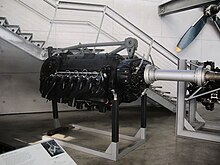Dornier Do 214
| Do 214 | |
|---|---|

| |
| Do 214 model at Dornier's museum in Friedrichshafen | |
| Role | Flying boat, Long range transport |
| Manufacturer | Dornier |
| Primary user | Luftwaffe |
| Number built | 0 |
The Dornier Do 214 was a proposed large long-range flying boat, developed by Dornier in World War II.
Development

Originally designed as the Do P.93 for passenger transatlantic service from Lisbon to New York, the Do 214 was redesigned as the P.192 for military service in early 1940. In 1941, a full-sized fuselage mockup was constructed in order to evaluate the interior layout. The fuselage was streamlined, having a round cross-section, with the interior consisting of two decks.
Its wings featured a small amount of
The mammoth eight-engine design was intended for use as a military transport, with a large bow door admitting vehicles and bulky freight to the upper deck. It was also designed for use as a long-range bomber, flying tanker, aerial minelayer and U-boat supply vessel. By 1943, it was realized that long-range flying boats were not needed due to the worsening war situation, and the Do 214 project was canceled.
Göppingen Gö 8
A 1/5 scale model glider of the Dornier Do 214 was designed and built as the
Specifications
The following specifications are for Do P.192-01 / Do 214 / civil airliner / DB 613C engines.
Data from Die deutschen Flugboote : Flugboote, Amphibien-Flugboote u. Projekte von 1909 bis zur Gegenwart,[1] Luftwaffe secret projects : strategic bombers 1935-45,[3] Die Deutsche Luftrüstung 1933–1945 Vol.1 – AEG-Dornier[4]
General characteristics
- Crew: 12 (Commander, pilot, co-pilot / navigator, 2x radio operator, flight engineer, 3x relief crew, 2x stewards, 1x chef)
- Capacity: 40 pax / 33,000 kg (72,753 lb) P.192-01 ; 333 troops P.192-03 ; 82,000 kg (180,779 lb) P.192-03
- Length: 51.6 m (169 ft 3 in)
- Wingspan: 60 m (196 ft 10 in)
- Height: 14.3 m (46 ft 11 in)
- Hull height: 6.5 m (21 ft) maximum
- Hull width 5.6 m (18 ft) without sponsons maximum
- Hull width 8 m (26 ft) over sponsons maximum
- Wing area: 500 m2 (5,400 sq ft)
- Empty weight: 76,000 kg (167,551 lb) [citation needed]
- Gross weight: 145,000 kg (319,670 lb)
- Fuel capacity: 66,000 L (17,000 US gal; 15,000 imp gal) in 21 lower hull fuel tanks, with a further 1,500 L (400 US gal; 330 imp gal) in outer wing tanks[clarification needed]
- Powerplant: 8 × Daimler-Benz DB 613C24-cylinder coupled V-12 liquid-cooled piston engines 4,000 PS (3,900 hp; 2,900 kW) at 2,700 rpm
- Propellers: 4-bladed VDM, 5 m (16 ft 5 in) diameter constant-speed propellers (tractor propellers)
- 4.6 m (15 ft) on translating extension-shafts (pusher propellers)
Performance
- Maximum speed: 490 km/h (300 mph, 260 kn)
- Cruise speed: 425 km/h (264 mph, 229 kn) [citation needed]
- Range: 6,600–8,100 km (4,100–5,000 mi, 3,600–4,400 nmi)
- Service ceiling: 7,000 m (23,000 ft)
Armament
- Guns: up to ten manned and remotely-controlled defensive cannon or machine-gun positions (armed variants)
See also
Related lists
References
- ^ ISBN 3879435650.
- ^ "Göppingen Gö-8". Planeurs (in French). Retrieved 8 December 2019.
- ISBN 1-85780-092-3.
- ISBN 978-3-7637-5464-9.
